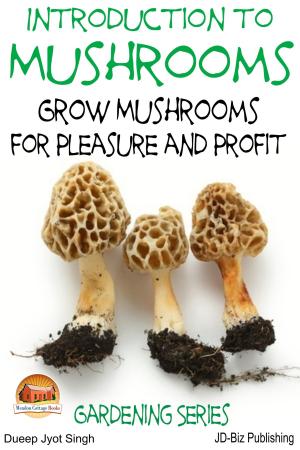Traditional Home Winemaking: Growing Your Own Home Wine Plants
Nonfiction, Food & Drink, Beverages, Wine & Spirits| Author: | Dueep Jyot Singh | ISBN: | 9781311923998 |
| Publisher: | Mendon Cottage Books | Publication: | June 20, 2016 |
| Imprint: | Smashwords Edition | Language: | English |
| Author: | Dueep Jyot Singh |
| ISBN: | 9781311923998 |
| Publisher: | Mendon Cottage Books |
| Publication: | June 20, 2016 |
| Imprint: | Smashwords Edition |
| Language: | English |
Table of Contents
Introduction
Factors Affecting the End Product
Choosing the Fruit
Use of Compost
Liquid Manure
Mulch
Improving the Soil
Tips for Location
Soft Fruit List
Blackberries
Strawberries
Raspberries
Loganberries
Blackcurrants
Rhubarb
Conclusion
Author Bio
Publisher
Introduction
I was just appreciating a glass full of homemade wine, with a very satisfying meal made by my friend François, and his wife Dominique, when he just happen to say – “homemade wine is all right when you know how to drink it!”
This is so true, because in a number of countries all over the World, it is permitted for you to make all the wine you want free of license and tax but it has to be consumed on the premises where it is made. It must not be sold. It cannot be given away. You cannot even give as much as a bottle for raffling at a charity bazaar.
So this book is going to tell you how you are going to grow your own wine plants, because I already wrote a book on winemaking some months ago. This book is being written under the assumption that you know a little bit of wine making and fruit growing, but if you want to refresh your knowledge, here is how you can make your own wine at home.
Many countries are trying to implement laws making it illegal for you to make any sort of wine at home, but they are playing a losing game. Winemaking has been the tradition, all over the World, for millenniums, and for centuries men have had their own family recipes and traditional recipes at home, passed down from generation to generation, in which wine for home consumption was brewed in the nearest available empty space.
Also, one should understand that the more a person is told not to do a thing, the more he is going to do it, as seen by the prohibition act. In the 1930s, the then government in America decided that it would be illegal to produce alcohol and to sell it. What happened then? The easy money boys immediately set up stills in which they began making rotgut liquor from ordinary homemade harmless brews.
People began to experiment with home distilling, which is a very dangerous practice, leading to insanity, violence, and other illegal activities, especially those caused by suspicion, which was inflamed by drinking too much of raw spirit.
Many people also got the idea of distilling homemade wines. Luckily, medicines, and common sense prevailed and the idea died as quickly as it was thought of. However, for a few really and apprising people who try to tamper with the original homemade recipe, distilling a homemade wine is not going to make it better. It also means that you are going through the risk of injury to health through drinking a raw spirit.
Table of Contents
Introduction
Factors Affecting the End Product
Choosing the Fruit
Use of Compost
Liquid Manure
Mulch
Improving the Soil
Tips for Location
Soft Fruit List
Blackberries
Strawberries
Raspberries
Loganberries
Blackcurrants
Rhubarb
Conclusion
Author Bio
Publisher
Introduction
I was just appreciating a glass full of homemade wine, with a very satisfying meal made by my friend François, and his wife Dominique, when he just happen to say – “homemade wine is all right when you know how to drink it!”
This is so true, because in a number of countries all over the World, it is permitted for you to make all the wine you want free of license and tax but it has to be consumed on the premises where it is made. It must not be sold. It cannot be given away. You cannot even give as much as a bottle for raffling at a charity bazaar.
So this book is going to tell you how you are going to grow your own wine plants, because I already wrote a book on winemaking some months ago. This book is being written under the assumption that you know a little bit of wine making and fruit growing, but if you want to refresh your knowledge, here is how you can make your own wine at home.
Many countries are trying to implement laws making it illegal for you to make any sort of wine at home, but they are playing a losing game. Winemaking has been the tradition, all over the World, for millenniums, and for centuries men have had their own family recipes and traditional recipes at home, passed down from generation to generation, in which wine for home consumption was brewed in the nearest available empty space.
Also, one should understand that the more a person is told not to do a thing, the more he is going to do it, as seen by the prohibition act. In the 1930s, the then government in America decided that it would be illegal to produce alcohol and to sell it. What happened then? The easy money boys immediately set up stills in which they began making rotgut liquor from ordinary homemade harmless brews.
People began to experiment with home distilling, which is a very dangerous practice, leading to insanity, violence, and other illegal activities, especially those caused by suspicion, which was inflamed by drinking too much of raw spirit.
Many people also got the idea of distilling homemade wines. Luckily, medicines, and common sense prevailed and the idea died as quickly as it was thought of. However, for a few really and apprising people who try to tamper with the original homemade recipe, distilling a homemade wine is not going to make it better. It also means that you are going through the risk of injury to health through drinking a raw spirit.















